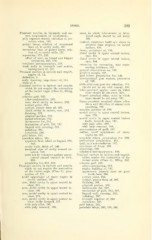Page 753 - My FlipBook
P. 753
INDEX. 399
Proximal cavities in bicuspids and mo- cases in which labiomesial or labio-
lars, preparation of (continued), distal angle should be cut away,
pulp exposure feared, variation in pro- 190.
cedure when, 160.
contact, sometimes build new closer to
pulpal horns, relation of recessional gingival than original, on mesial
lines of, to cavity walls, 157. surface, 190.
recessional lines of pulpal horns, rela- decay, recurrence of, 186.
tion of, to cavity walls, 157. distal cavity in upper central incisor,
separation, 171, 259. case, 184.
effect of wide, on buccal and lingual
distal cavity in upper lateral incisor,
extensions, 166, 172. case, 186.
tabulated instrumentation, 118.
extension for prevention, case repre-
weak walls in bicuspids and molars,
senting minimum, 185.
management of, 167.
general observations on, 189.
Proximal cavities in incisors and cuspids,
gingival margin, 189.
angles of, 12.
gold inlays, preparation for, 340.
definition, 3.
interproximal gum septum, protection
early discovery, importance of, 145.
of, 189.
walls of, 8.
iridio-platinum post for retention, 188.
Proximal cavities in incisors and cuspids
should not be set with cement, 198.
which do not require the restoration
labio-proximal angles, cases in which
of the incisal angle (Class 3), filling,
same should be cut away, 190.
282.
lingual marginal ridge, cases in which
cohesive gold, 282.
same should be cut away, 191.
after-condensation, 285.
linguoproximal marginal ridges often
case, distal cavity in incisor, 282.
sharp and direction of enamel rods
contact point, 285.
uncertain, 191.
contact, proper form of, 295.
margins, position of, 189.
distal cavity in incisor, case, 282.
mesial cavitv in upper central incisor,
finishing, 291.
gingival portion, 283. case, 178.
incisal retention, 284. mesial cavity in upper central incisor
instruments for, 282. badly decnved, case, 187.
lamination of gold, 283, 287. with pulp alive, 188.
lingual wall, covering, 283. with pulp removed, 188.
polishing, 297. non-conductor of quill, 187.
variations, 286. outline, avoid appearance of sharp
gold inlays, 340. angles in, 190.
porcelain inlays, 338. porcelain inlays, preparation for, 338.
approach from labial or lingual, 338, preliminary preparation, 178.
340. quill, as a non-conductor, 187.
cavity walls, finish of, 340. recurrence of decay, 186.
marginal edge of cavity toward ob- separation, 259.
server, 340. tabulated instrumentation, 119.
must not be cemented against unsup- Proximal cavities in incisors and cuspids
ported enamel exposed to view, which require the restoration of the
339. incisal angle (Class 4), filling, 282.
separation for, 338, 339. cohesive gold, 282.
Proximal cavities in incisors and cuspids after-condensation, 285.
which do not require the restoration angles, building of, 287.
of the incisal angle (Class 3), prep- appearance depends most on good
aration of, 177. tooth form, 196.
avoid appearance of sharp angles in contact point, 285.
cavity outlines, 190. contact, proper form of, 295.
case, distal cavity in upper central in- finishing, 291.
cisor, 184. gingival portion, 283.
case, distal cavity in upper lateral in- instruments for, 282.
cisor, 186. lamination of gold, 283, 287.
case, mesial cavity in upper central in- lingTial wall, covering, 283,
cisor, 178. polishing, 297.
case, mesial cavity in upper central in- strength required of, 246.
cisor, badly decayed, 187. variations, 286.
with pulp alive, 188. gold inlays, 341.
with pulp removed, 188. porcelain inlays, 196, 198, 340.


